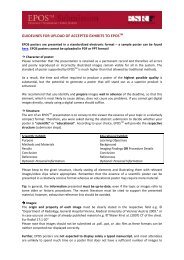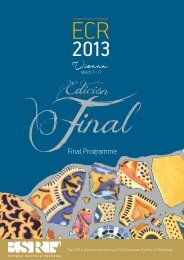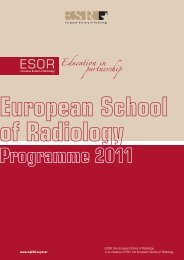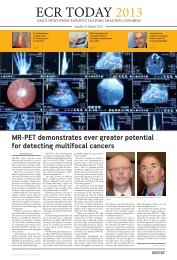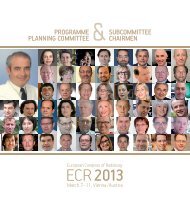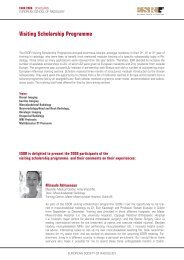New Horizons - myESR.org
New Horizons - myESR.org
New Horizons - myESR.org
- No tags were found...
Create successful ePaper yourself
Turn your PDF publications into a flip-book with our unique Google optimized e-Paper software.
www.<strong>myESR</strong>.<strong>org</strong> | EUROPEAN CONGRESS OF RADIOLOGY 2013Multidisciplinary work is a reality in most fields of medicine, and radiologists have a centralplace in patient management, providing their expertise at every step of patient care. The bestexample is probably oncologic medicine, where radiologists assist and sometimes guide thedetection, staging, treatment delivery and follow-up of cancer. But overall, they remain too farbehind in the initial phase of patient management and let other specialists conduct the diagnosticinvestigation. To this day, radiologists still send their reports in the post without liaising directlywith the referring physician. Their contact with patients is sometimes non-existent or very limited.As a result, patients have to wait several weeks for a complete diagnosis to be made and receivetreatment. This situation has become unsustainable, as too much time, money and energy is lostin the process, Prof. Adam believes.Andy Adam, professor ofinterventional radiology at theUniversity of London, will speakabout the role of the radiologist inthe 21 st century.“This is a crazy way to practise medicine in the 21 st century. Radiologists act as if they weretechnicians: they take a picture, explain what it shows in a report, and send it to the referringdoctor. Then the doctor asks for another imaging test, and this goes backwards and forwardsmaybe six, seven or eight times, sometimes more. This costs a lot of money and generates a lotof anxiety for the patients and their families, who always wonder whether a test result is goingto be normal or not,” he explained.A much more sensible way would be for the radiologist to act as a clinical doctor and contactthe referring physician directly when significant abnormalities are spotted. “There’s no reasonwhy the radiologist, when he or she sees a clear abnormality, can’t talk to the doctor who sent thepatient and <strong>org</strong>anise things in a practical way to speed up the investigation,” he said.If radiologists took on the role of guiding the investigation rather than just responding to arequest, the whole diagnostic process could be accelerated, money could be saved and clinicaloutcomes and patient welfare could be improved. A practical solution would be to have a seniormember of staff acting as a consultant, to liaise directly with the referring physician and the patient,Adam suggested. Radiologists from the same department could take turns for a few hours a week.“In certain cases, there’s no reason why we can’t have a consultant in the morning and one inthe afternoon, whose job it is to discuss things with the patients, phone up the physician whosent the patient, and explain what they have seen and make recommendations. We could reallyspeed things up if we did that. Some of it is happening already and we could do more if we wereprepared to change the way we work,” he said.This last point probably remains the biggest challenge of all. Convincing radiologists thatthey should change their work habits will prove a tough nut to crack, even if it is in their and thepatient’s best interest.“Cultural changes are always the hardest in anything. People are not used to working differentlyso they could give you 20 reasons why things can’t be changed. But there is no doubt thatwe will need to do that, and we will need to emerge from the dark, talk to patients and doctors,and guide the whole investigation,” he concluded.Preliminary Programme EdiciÓn Invierno | ECR 2013 53




